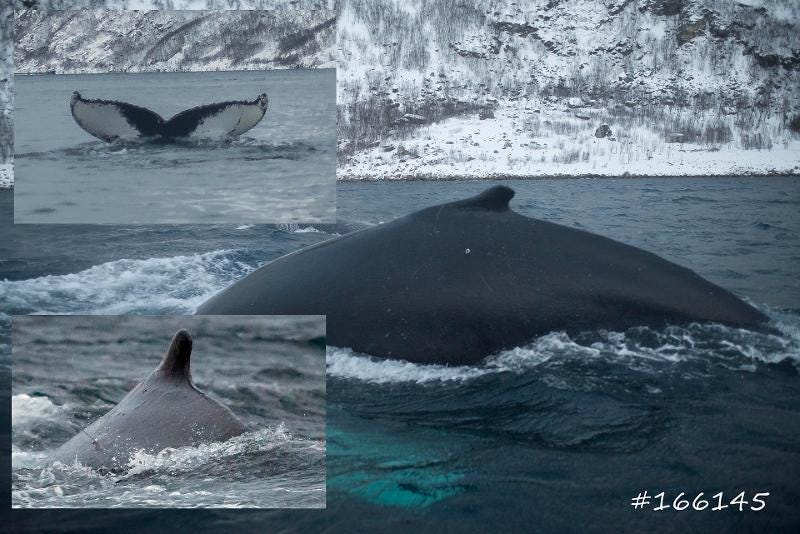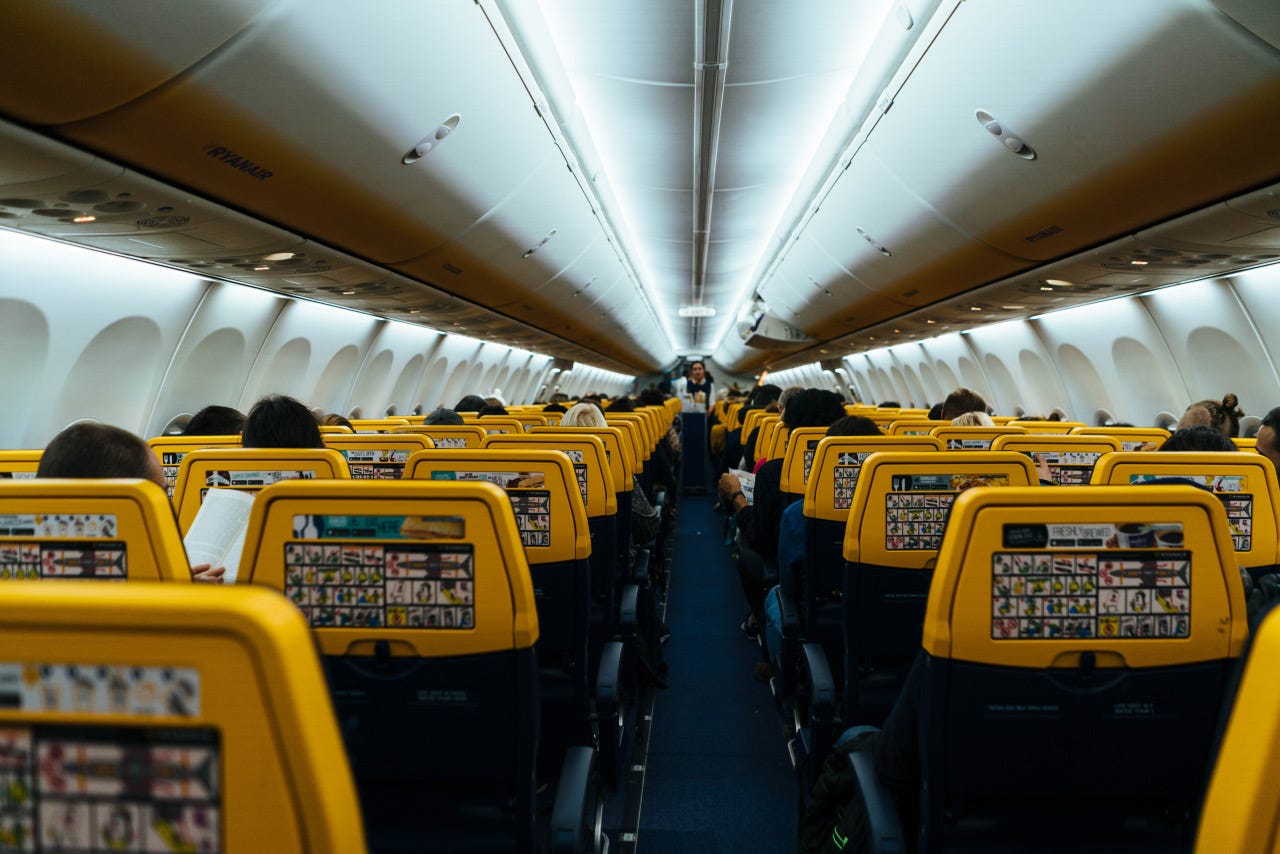24 October 2023. Whales | Strategy part 2
Looking for the humpback whales // The problem with ‘The Crux’
Welcome to Just Two Things, which I try to publish three days a week. Some links may also appear on my blog from time to time. Links to the main articles are in cross-heads as well as the story. A reminder that if you don’t see Just Two Things in your inbox, it might have been routed to your spam filter. Comments are open.
1: Looking for the humpback whales
Kathleen Jamie, the current Scots Makar, is also an accomplished nature writer, and she has an article in a Scots nature ‘zine called Paperboatsabout watching whales in the Firth of Forth.
Close to shore is Inchkeith, with its concrete WW2 fortifications still visible; far out lies the bird-rich Isle of May, and the Bass Rock, gleaming under its huge population of gannets. They’ve been islands since the Ice Age ended. Out in the firth, several ships are riding at anchor, tankers mostly, rust red and blues, waiting to be loaded with oil. How calm they seem, almost innocent. Like cigarette ads were, once.
The Firth of Forth is dominated by ships, some heading for the oil refinery at Grangemouth, and it is possible to follow these on an app called Marine Traffic:
You can discover that the reddish one off Kinghorn is an LPG tanker, sailing under the flag of Malta, having arrived from Portugal. That blue one farther out is the Speciality, an oil/chemical tanker on its way from Rotterdam to Grangemouth. Yet another is registered to the Marshall Islands, a Pacific nation already drowning as sea levels rise.
(A humpback whale. Photo: Natural England/ flickr. CC BY-NC-ND 2.0)
But she’s there for the whales, not the ships. A couple of humpback whales have been seen in the Firth of Forth, visible enough that there’s footage on youtube. But you have to look, because unlike ships whales don’t send out a signal every three minutes.
If they’re out there, they’re travelling under cover, except when they breathe. They must navigate unassisted, dodging the din and infrastructure, the eroding rigs, the stanchions and propellers, the offshore wind farms, tugs and fishing gear. Perhaps even now one or the other is moving past the Sarnia Liberty, an ‘oil products tanker’ (Hazard A – Major) which is turning slowly as the tide ebbs... You scan the East Lothian coast with its new housing and wind turbines on the hills beyond. Then it’s back to quartering the sea, looking for a blow, a dark back.
As she scans, in that reverie of looking, she wonders what the world would be like if whales had apps as well.
Maybe the whales would be given heroic names, like ships. Imagine if Ocean Valiant was a blue whale, not a superannuated oil rig. Or if Viking Warrior was a great living creature, rather than a tug manoeuvring a tanker. We’d gain a knowledge of a sort, but lose the reward for patience, and the chance encounter, the astonished what was that? No more flukes, so to speak.
And it turns out that this is idea isn’t so fanciful after all. Audun Rikardsen, a Norwegian biologist and Arctic wildlife photographer, and a team from Tromsø University have been attaching satellite tags to whales and orca, to follow them across the oceans, tagging them as they feed on the herring shoals around Svalbard and in Norway’s fjords.
(Satellite tagged whales. Photo: Audun Rikardsen.)
Over the past dozen years, North Norwegian Humpback Whale Catalogue (NNHWC) has tagged 900 whales., and another 300 tagged in the Barents Sea. And it turns out that whales do take some following:
The project’s website shows a jagged fizz of coloured lines in the Barents Sea which in time becomes half a dozen ribbons unfurling gently across the Atlantic. Each coloured ribbon shows a particular whale migrating south-west to the balmy waters of the Caribbean, their breeding place, a three-month journey. Sometimes they amble. No. 47570, for example, took a long whale-road round the north of Iceland. For a while, No.166149 sported off the Butt of Lewis. The researchers say that one individual reached the waters off Guadeloupe, but remained there for only two hours before heading north again.
Eventually the tags fall off and their ocean trails stop. And, that day at least, Jamie sees no whales: only ships.
Thanks for Ian Christie for the link to Paperboats. Audun Rikardsen’s gallery of Arctic wildlife photography is well worth your time.
2: The problem with ‘The Crux’
In part 1 of this review, I summarised Richard Rumelt’s idea of ‘the crux’ as a core strategy issue: the nub of the problem, the part that needs to be understood and resolved if a strategy is to succeed. In part 2, I get into some of the issues with it.
When you get into Rumelt’s examples, it’s sometimes hard to work out why the example is a crux and not just an important business issue. The first version of Ryanair, which took advantage of deregulation to compete with British Airways and Aer Lingus between Dublin and Heathrow, went out of business as BA, in particular, adjusted its prices to compete.
So “the crux” here was how to fly passengers between Ireland and Britain without going out of business. The answer, it turned out, was to copy South Western Airlines, unbundling prices and flying to second-tier airports around London, and later rolling out the same approach across Europe. Rumelt doesn’t mention it, but the key to reducing prices was to increase the intensity of the flight schedules, accelerating turnround times at airports and therefore increasingly the likelihood of delays and disruption. So perhaps the crux here is actually the insight, or discovery, that customers will tolerate quite a lot of inconvenience for a modest reduction in the end-to-end cost of travel if some of those costs are disguised.
(Ryanair interior. Photo Marco Verch, CC BY 2.0)
Sometimes this is more straightforward. Rumelt talks about the dilemma that Amazon had when it developed its MarketPlace service. It needed other companies to join to create scale and therefore traffic. But it didn’t want to give a leg up to competitors. The crux was to provide logistics services to those competitors, tying them in to Amazon. Of course, if you read the Federal Trade Commission’s case against Amazon, this quickly turned into alleged anti-competitive behaviour.
The extent to which the book is “bracingly direct” comes down to two things. The first is that he is scathing about the financialisation of the modern corporation, which, he says, has nothing to do with strategy. He tells an entertaining story from class:
”This term”, he tells his students, “I will forecast your performance in this course based on your past grades in other courses. Then, I will grade you on the degree to which you beat, or fall below, those forecasts.” (p.86)
When the students complain, he points out that this is how the stock market appraises CEOs.
But growth itself is also largely unpredictable:
Whenever I look at growth rate data across numerous firms, I am always impressed at how truly random it is. (p.85)
The second is his view of strategy as being about the execution of power within the organisation. He believes that someone has to choose. He tells a story about meeting a group of Swedish management academic colleagues who suggest to him an ecological or network-based model of how businesses and organisations work. He gives them short shrift.
I had heard all this before... A strategy is a design and direction imposed by leadership on an organization. Strategy began when people realized that telling warriors to 'go out and fight the invaders didn't work... In a modern business, a strategy is the exercise of power to make parts of the system do things they would not do, if left to themselves" (p.110)
There’s an interesting section (for a futurist) on understanding long waves of change in thinking about innovation. He does regard this as a necessary part of the strategist’s knowledge base. He is also old enough to have attended one of Hermann Kahn’s workshops in the late 1960s looking out to the year 2007.
He wasn’t impressed. It seemed to produce a wish-list: curing cancer, colonies on Mars, hyper-sonic travel on Earth.
One lesson is that the strategist needs to know the nature of the long wave being considered. Some advance greatly over time, while others, like ship propulsion, seem to reach natural limits... The somewhat predictable technological future seems to be about five to seven years off (p.206).
Shorter waves, he suggests, tend to appear when the costs become low enough to permit commercialisation, and there’s an initial customer base which is reasonably price insensitive. Sometimes this produces sub-optimal outcomes. The early adopters of mobile phones in the US were drugs dealers who needed hyper-local coverage. They were served well enough by the analogue AMPS system, while Europe pushed on with digital standards.
There were times when I wished that he was applying these tools and his intellect to more substantive problems, and sometimes with a broader eye. It’s easy enough to point out the difficulties with the 17 SDGs, for example (pp128-130), which are goals, not strategies, and ignore the other forms of political lifting that they are doing.
It is pretty clear that the core audience for this book is American business execs (and wannabees), and their international counterparts, but that means that quite a lot of the language is about “winning”—as in, strategic leaders have created “a call to attack and conquer” a part “of reality” where “we can actually win” (p38).
The “we” is doing some interesting work there, and it reminded me of tedious meetings when I worked for a commercial consultancy where clients would tell me that they needed to know where they needed to play, and how they could win. But so much of strategy ought to be about building, not competing.
My more significant reservation here is that this is all a very particular language framed within a very particular discourse. The whole analogy of “the crux” is based on the individual trying to overcome their environment. In the business environment this translates to individuals using strategy to exert power so the organisation can “win”. I probably don’t need to spell this out further.
But in my own experience it is possible to use tools that help people have honest generative conversations about their environment, their goals, and their critical difficulties. And in such a way that their crux issues emerge from the conversation, and therefore are identified together by the group. I’m not sure that Rumelt would recognise this experience, though.
If you are interested in strategy, and haven’t read Good Strategy Bad Strategy, I’d definitely start there. Your decision to move on the The Crux after that probably depends on how interested you are in business strategy. With that in mind, two sections here have real value. The first is the sequence of chapters on ‘Diagnosis’, which includes an analytical critique of consulting frameworks. Secondly, his description of The Foundry process in the final chapters is worth understanding, even if it needs a critical reading.
j2t#507
If you are enjoying Just Two Things, please do send it on to a friend or colleague.





